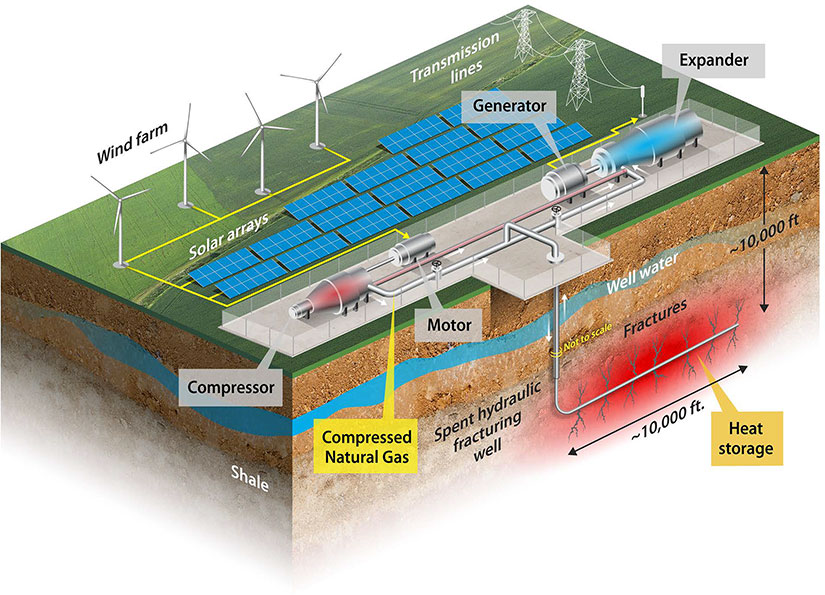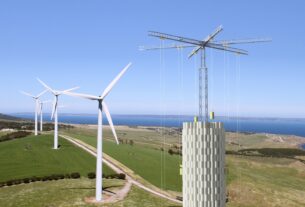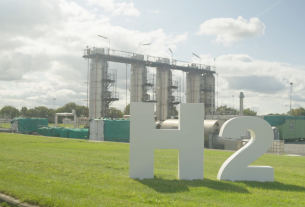United States – Chad Augustine and his colleagues at the National Renewable Energy Laboratory (NREL) have proposed using depleted oil and gas wells as a reservoir for compressed natural gas storage.
The gas can be released as needed to spin a turbine and generate electricity. The reservoir is recharged using excess grid electricity, and the cycle is repeated, potentially providing a solution to the growing demand for energy storage. Scientists at NREL and Colorado School of Mines confirmed the idea’s viability through computer modeling.
Limits to underground storage
A similar concept, using man-made salt caverns to store compressed air, has been proposed and implemented—but only in two places on the planet. Because geological salt dome formations are required, the technology is geographically limited.
The proposal to use depleted oil and natural gas wells capitalizes on an increase in the number of horizontal, hydraulically fractured, or “fracked,” wells. The technique, which the Energy Information Administration estimates accounts for roughly 75% of all newly drilled wells in the US, drills down and then straight across the rock. After that, high-pressure water is pumped into the well to fracture the shale and release trapped oil and natural gas.
David Young, a senior scientist at NREL specializing in solar technology, had a “eureka” moment when he came up with the idea of using old oil and gas well sites for storage. Young presented his concept to Augustine. They examined the idea in depth with Henry Johnston, an oil and gas industry veteran who worked at NREL for six years before retiring at the end of January.
Horizontal wells, with multiple wells drilled from a single pad, have become the industry standard. The volume produced exceeds that of vertical wells, but the amount of oil and natural gas produced by horizontal wells decreases over time. Wells that are active can quickly become inactive.
Eventually, the wells become so depleted that it is no longer profitable to keep them running. These wells can then be left to rot or plugged with cement. Researchers at NREL and Mines discovered that unplugged wells could be used as compressed natural gas reservoirs.
After running multiple rounds of computer simulations, researchers at NREL and Mines discovered that unplugged wells can be injected with compressed natural gas. The scientists predicted in the Journal of Energy Resources Technology that the technology would work for both short-term and long-term energy storage. Following that November paper, NREL researchers published an article in iScience a month later that examined the potential costs.
The next step, according to Augustine, is to launch a pilot project to bring computer modeling into the real world. The issue of transmission lines remains unresolved. The number of active horizontal wells has increased from around 9,000 in 2000 to over a quarter-million in 2017.
Augustine and his colleagues’ research was funded by the Department of Energy’s Geothermal Technologies Office, which is also investing in the potential use of inactive wells for geothermal energy.
Compressed air injection
Initially, the NREL researchers considered injecting compressed air into the old wells. In 2016, Augustine applied for the Department of Energy’s Energy I-Corps program. The program assists researchers in determining the market potential for their technology. Augustine discovered that injecting air into a natural gas well increases the risk of an explosion. They chose natural gas because it was readily available and compatible with the reservoir.
Using compressed air as an energy storage medium necessitates additional steps, such as cooling the air after compression and preheating it before releasing it. Compressed air projects can also take years to complete and cost hundreds of millions of dollars. The scientists estimate that by utilizing existing wells, a natural gas pilot site can be installed for a few million dollars within months.
Their calculations show that, depending on the temperature and pressure in the well, using compressed natural gas to generate electricity can generate anywhere from hundreds of kilowatts to nearly a megawatt.
The REFRAES (for REpurposed FRAcked wells for Energy Storage) technology works in four stages. The gas is injected into the reservoir at a constant flowing bottomhole pressure in the first step to store energy. The well is then sealed, preventing the gas from escaping. The gas is then extracted from the reservoir at a constant pressure in order to generate electricity. Finally, there is a recovery period in which the well is shut down again.
The storage cycle is restarted after the recovery period. The process can provide six hours of electricity in the short term. The researchers estimate that it can provide 90 days of electricity for longer-term or seasonal needs.
Pumped hydro, which uses water flowing downhill to generate electricity, can return 70–85 percent of the stored energy. The efficiency of REFRAES was calculated by NREL researchers to be between 40% and 70%. Natural gas storage could have a levelized cost of $80 to $270 per megawatt-hour, whereas pumped hydro has a levelized cost of $225.
Another advantage of REFRAES technology over pumped hydro and the two reservoirs required is its ability to be expanded. Augustine explained that by drilling multiple wells on a single site, the method of storing natural gas can expand as needed by tying in additional holes. If a single well, for example, can store 500 kilowatts of energy, adding each subsequent well increases the available storage capacity.




